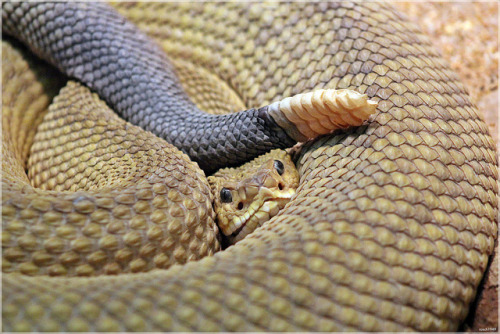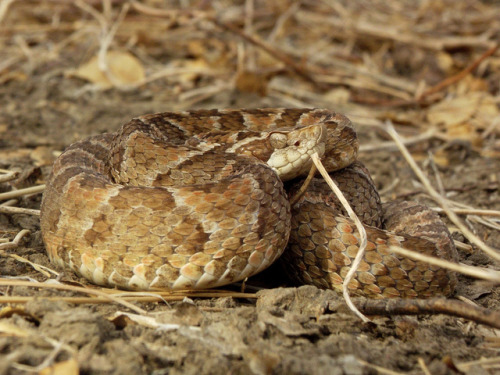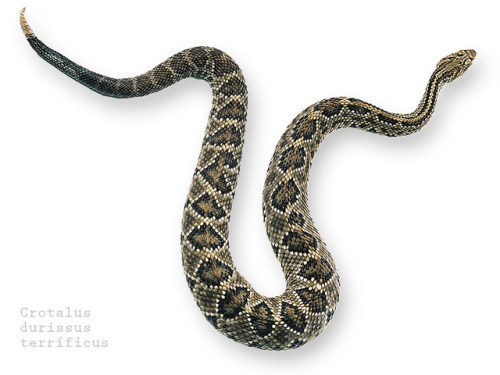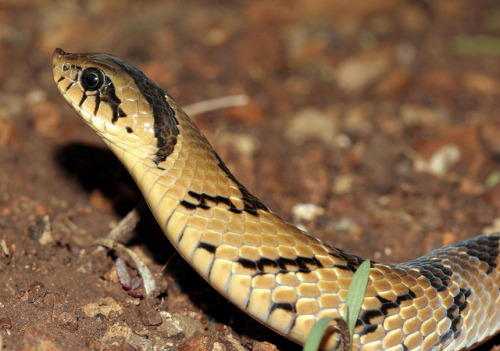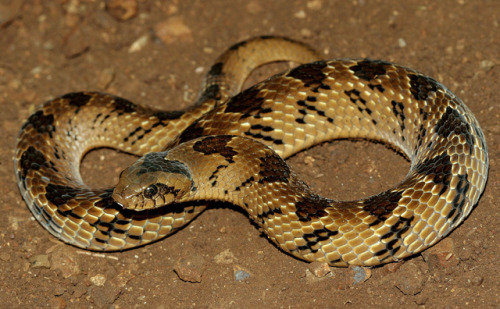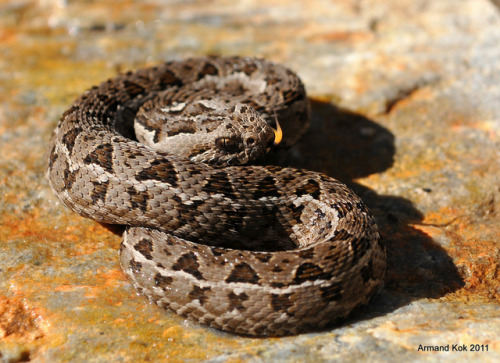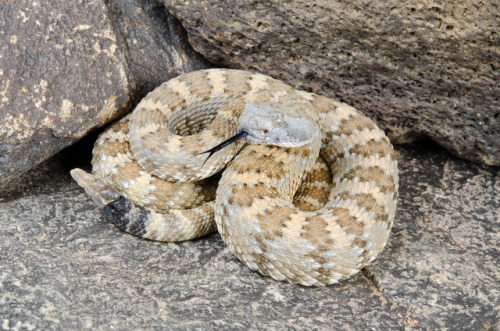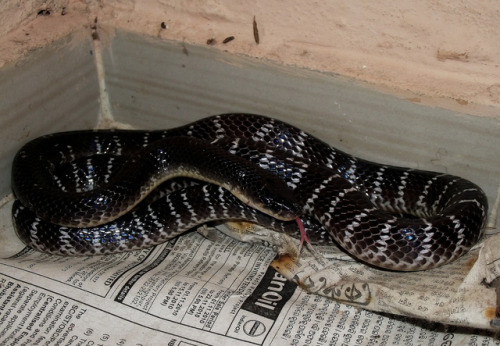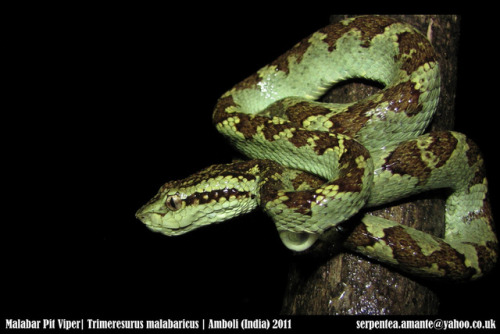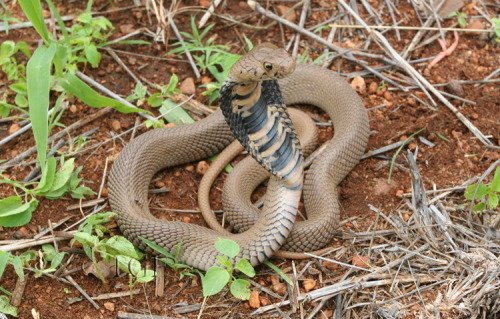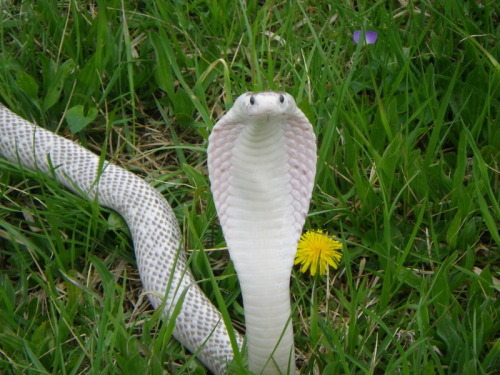(Crotalus polystictus) Mexican lance-headed rattlesnake , lance-headed rattlesnake
Likely to be mainly hemotoxic (& probably w/ tissue-necrotoxic factors). This species’ long fangs & large average venom yield make it a potentially dangerous snake; envenomation of humans has resulted in severe symptoms.
Post link
(Bitis gabonica) Gaboon viper
Longest fangs of any snake species in the world, often 40 mm long (max. 55 mm), which enable it to inject massive amounts of potent cytotoxic venom deep into a victim. Venom also contains cardiotoxins that possess neurotoxic properties which may be more dangerous than the cytotoxins.
Post link
(Naja mossambica) Mozambique spitting cobra
Venom mainly cytotoxic & can cause considerable tissue damage; neurotoxic symptoms generally minor. Bites of humans infrequent & fatalities rare. Neurotoxic symptoms may occur if unusually large dose of venom is injected. Large specimens can “spit” venom >1.0 m.
Post link
(Causus rhombeatus) Rhombic night adder, demon night adder, Cape night adder, African night adder, Cape viper
Rhombic Night Adder bites can be very serious and in at least one bite a child had to have a fasciotomy. We see a number of small dogs dying and having limbs amputated. A bite from a large individual on a small child could potentially be fatal - please do not underestimate the venom of this snake.
The few documented bites involved pain and minor swelling with minimal necrosis. These symptoms usually disappear within 2–3 days. There have been no modern well-documented cases to back up earlier claims of fatalities due to bites from this species. Venom yield has varied from 20–30 mg to 300 mg, but the venom toxicity is low with LD50 values of 10.8, 14.6, >16.0 mg/kg IV and 15 mg/kg SC being reported.
No reliable reports of fatalities. No known antivenom currently being produced.
Post link
(Bitis atropos) Berg adder
Unusual among Bitis species in that its venom is predominantly neurotoxic, so much so that the effects of the bite seldom include necrosis or infection. The snake is described as “irascible”, hissing violently and twisting convulsively if molested.
Presumably, the neurotoxic venom is an adaptation to the prey, which largely comprise of rock lizards and small amphibians. It does, however, also eat other animals, such as small rodents and young of ground-nesting birds. The venom is not powerful enough for the dose injected at a single strike to kill an adult human, and there do not seem to be any records of human fatalities. However, whether at threat or not, patients do not seem to respond usefully to antivenin, so treatment should be limited to symptomatic control. Such as the effects of the venom are, they take effect quickly. Symptoms of the bite have been compared to alcohol intoxication and are not permanent. Unlike the bites of elapid snakes,Bitis atropos bites, though neurotoxic, do not cause obvious effects on heart and respiratory functions. However, they can be troublesome and their effects sometimes persist for some days or even weeks, which suggests the venom causes nerve damage that does not mend quickly if it is severe. Obvious symptoms may include loss of smell or taste, drooping eyelids and loss of vision.
Post link
(Bungarus caeruleus) common krait
Potent neurotoxin. Most victims bitten while asleep in huts at night. Bites may produce invisible or barely perceptible puncture marks. Few local symptoms; may produce mild pain or numbness w/ little or no local swelling. Human mortality rate is high without use of antivenom.
Post link
(Bitis rubida) red adder
Venom contains primarily weak cytotoxin, causing pain & local swelling; unlikely to be lethal to humans. Very few bites of humans recorded, causing slight swelling & discoloration at the bite site. No known specific antivenom currently produced.
Post link
(Crotalus cerastes laterorepens) Colorado Desert sidewinder
The Colorado Desert sidewinder is found in Sonoran Desert areas, from central and eastern Riverside County, CaliforniatoPinal County, Arizona in the United States, and south to northwestern Sonora and northeastern Baja California states in Mexico. It is in areas from the Lower Colorado River Valley to the surrounding desert foothills, at elevations between 152–610 metres (499–2,001 ft). The type locality given is “The Narrows, San Diego County, California” (USA).
Campbell and Lamar (2004) describe its range as the desert regions of southeastern California, southwestern Arizona, as well as the western panhandle region of the Sonoran Desert.
Post link
(Cerastes cerastes) desert horned viper
C. cerastes venom is not very toxic, although it is reported to be similar in action to Echis venom. Envenomation usually causes swelling,haemorrhage,necrosis,nausea,vomiting, and haematuria. A high phospholipase A2 content may cause cardiotoxicityandmyotoxicity. Studies of venom from both C. cerastesandC. vipera list a total of eight venom fractions, the most powerful of which has haemorrhagic activity. Venom yields vary, with ranges of 19–27 mg to 100 mg of dried venom being reported. For venom toxicity, Brown (1973) gives LD50 values of 0.4 mg/kg IV and 3.0 mg/kg SC. An estimated lethal dose for humans is 40–50 mg.
Post link
(Vipera aspis atra) black asp, black viper
Found in western Switzerland, northwestern Italy,Spain, and southeastern France. This subspecies is classified as Vulnerable.
Post link
(Calliophis intestinalis) Banded Malaysian coral snake, Brown long-glanded coral snake, Striped coral snake
Not much known, but probably neurotoxic. Not reported to have caused any human fatalities.
Post link
(Bothrocophias campbelli) Campbell’s toadheaded viper or the Ecuadorian toadheaded pitviper
Potent hemotoxic venom, envenomation by 3 closely-related species in this genus have caused human deaths, frequently cause severe necrosis, & may lead to amputation of human limbs.
Post link
(Naja mossambica) Mozambique spitting cobra
This snake is nervous and highly strung. When confronted at close quarters this snake can rear up to as much as two-thirds of its length, spread its long narrow hood and will readily “spit” in defense, usually from a reared-up position. By doing this the venom can be ejected at a distance of 2–3 metres (6½-10 feet), with remarkable accuracy. This spitting cobra does bite depending on its environment and the situation it is in, and also shares the same habit with the Rinkhals of feigning death to avoid further molestation. When in a confined area like a tube the reptile will bite instead of spit. The eggs average 10 to 22 in number, hatchlings measure 230-250mm
♥ ♥ ♥ ♥ ♥ ♥ ♥ ♥ ♥ ♥ ♥ ♥ ♥ ♥ ♥ ♥ ♥ ♥ ♥ ♥ ♥ ♥ ♥ ♥ ♥ ♥ ♥ ♥ ♥ ♥ ♥ ♥ ♥ ♥ ♥ ♥ ♥ ♥ ♥ ♥ ♥
Post link

